Brief: Creating a Targeted Prospecting Strategy
Sales performance improvement

Published: August 22, 2018
What is the most effective way to create a targeted prospecting strategy that drives more qualified leads and wins in complex B2B sales?
Creating an effective targeted prospecting strategy in B2B sales means focusing your time, tools, and message on the prospects most likely to become profitable customers. In a market where sales tools are abundant and buying committees are larger, the key is to work smarter—not just harder—by following a structured, repeatable approach. The most successful strategies combine clear audience targeting, disciplined qualification, and consistent engagement, all supported by measurable goals.
Here’s how to do it:
- Establish a Prospecting Playbook – Clearly define your Ideal Customer Profile (ICP), outline their pain points, and determine the best messaging to address them. Ensure every sales rep communicates with the same tone, positioning, and value proposition so prospects get a consistent brand experience.
- Qualify Opportunities Quickly – Use a clear, ordered set of questions to determine whether a lead has a genuine need, whether you can realistically compete, whether they are likely to buy, and whether the revenue potential justifies pursuing them. This prevents wasted effort on low-value opportunities.
- Use a Need-Benefit Statement to Open Conversations – Begin with a concise, tailored statement that connects the prospect’s specific challenge to the unique benefit you can provide. Keep it factual, relevant, and supported by real customer success stories to quickly earn attention.
- Keep the Conversation Alive, Even After Setbacks – When a prospect disengages or raises objections, listen closely, acknowledge their concerns, and ask clarifying questions to understand the root issue. Avoid defensiveness and maintain a value-driven dialogue so the door stays open for future opportunities.
- Review Every Win and Loss (“Post-Game” It) – After each deal, closed or lost, analyze when engagement peaked or dropped, which stakeholders were involved, and how well your message landed. Use these insights to refine your ICP, improve messaging, and adjust your qualification process.
A targeted prospecting strategy is not a one-off campaign; it’s a long-term discipline. Maintain a regular outreach cadence, set clear activity and revenue goals, and focus on providing value before asking for a commitment. By consistently targeting the right people with the right message at the right time, you’ll generate more qualified leads, shorten sales cycles, and improve your close rate.
In this article, you'll learn:



The questions that help sales reps separate high-potential leads from low-value ones, and how to craft a need-benefit statement that earns a decision-maker’s attention in seconds.
How to keep conversations alive after setbacks, analyze wins and losses for insights, and maintain a consistent prospecting rhythm that fuels your pipeline year-round.
Keep exploring: Complete the form below to download the extended brief: Creating a Targeted Prospecting Strategy to get even more tips for successful B2B prospecting.
Prospecting has always been the lifeblood of sales, but today’s environment makes it both more challenging and more critical than ever. Buyers have more options, access to more information, and often involve multiple stakeholders in every decision. Meanwhile, sales professionals are navigating a growing array of enablement tools, data sources, and outreach channels—each promising to deliver better leads but often adding complexity to the process.
In this environment, a scattershot approach to prospecting no longer works. Sales teams need a structured, targeted strategy that ensures every call, email, and meeting is focused on the right opportunities. This means knowing exactly who you want to reach, how to engage them in a meaningful way, and how to move them through the buying journey efficiently.
The sections that follow outline five essential pillars of an effective targeted prospecting strategy—covering everything from defining your ideal customer and qualifying leads to keeping conversations alive and continuously refining your approach. Think of it as a practical, repeatable framework you can adapt to your market, team, and sales goals.
Establish a Prospecting Playbook
A successful sales team doesn’t rely on guesswork—they operate from a clearly defined playbook that standardizes how prospects are identified, approached, and nurtured. Without this alignment, each salesperson may work from their own assumptions, leading to inconsistent results and diluted messaging.
Research from HubSpot shows that teams with formal playbooks have seen up to 33% higher win rates because they are better able to retain consistency, speed onboarding, and scale more efficiently.
It’s not enough to know who to target—you must also determine how to engage them and why they should care. The playbook ensures that every team member is delivering the same core messages, in the same tone, and in the most effective sequence.
Key actions include:
- Adopting a brand marketing mindset – Think strategically about your audience and their buying triggers.
- Creating an Ideal Customer Profile (ICP) – Detail the industries, company sizes, pain points, and decision-making roles that define your best customers.
- Crafting a core value message – Develop a clear statement of your competitive advantage.
- Maintaining consistency – Ensure all outreach reflects the same positioning and tone.
Qualify Prospects Quickly and Accurately
Many sales pipelines suffer from “clutter”—opportunities that are unlikely to close but continue to consume valuable time and energy. The ability to quickly determine whether a lead is worth pursuing is one of the most important sales skills in B2B. This is where a disciplined qualification process comes into play, helping sales teams invest effort where there’s true potential.
By establishing a clear order for qualification questions, you not only save time but also improve forecasting accuracy and resource allocation. A prospect that is not a good fit can be disqualified respectfully, freeing you to focus on leads that meet both strategic and financial criteria.
A proven qualification sequence:
- Identify need – Does the prospect have a challenge your solution can address?
- Evaluate competitiveness – Are you realistically positioned to compete for this opportunity?
- Assess win potential – Is there genuine buying intent and alignment among decision-makers?
- Weigh potential value – Does the possible revenue justify the investment of time and resources?
Prepare a Powerful Need-Benefit Statement
The opening moments of a conversation with a prospect often determine whether you’ll secure a meeting or get a polite brush-off. This is where the need-benefit statement becomes your secret weapon. It’s not a pitch—it’s a laser-focused connection between what the buyer is struggling with and the specific value you can deliver.
The strength of a need-benefit statement lies in its relevance and brevity. Decision-makers don’t have time for long-winded intros, but they will respond to a clear, targeted message that reflects their reality and offers a credible path forward.
Best practices for crafting your statement:
- State the need – Articulate the challenge the buyer is facing, based on your research.
- Link to your benefit – Show how your solution directly addresses that need.
- Use relevant examples – Reference real customer results to add credibility.
- Avoid hype – Keep the tone professional and fact-based.
Keep the Conversation in Play
In B2B sales, “no” is rarely the end of the story—it’s often just a temporary pause. Prospects may disengage due to shifting priorities, budget constraints, or internal politics, but those situations can change quickly. By handling disengagement skillfully, you maintain the relationship and keep yourself positioned for future opportunities.
The key is to treat every interaction as a chance to gather intelligence. Even negative responses hold clues about what matters most to the buyer, what objections they have, and how you might reposition your value in the future.
How to keep momentum after a setback:
- Listen actively – Take in what’s being said without rushing to respond.
- Acknowledge concerns – Show empathy to build trust and credibility.
- Ask clarifying questions – Uncover the real reason behind hesitation.
- Stay constructive – Avoid defensiveness and focus on their needs.
Post-Game It: Analyze Wins and Losses
Sales excellence is built on continuous improvement, and that requires looking back as well as forward. A post-game review—after both wins and losses—helps identify the exact points in the process where you excelled or fell short. This isn’t about blame; it’s about gathering actionable insights to refine your approach.
Over time, these reviews help you identify patterns: which buyer profiles respond best to your outreach, which messages resonate most, and where in the process leads tend to drop off. Armed with this knowledge, you can adapt your strategy and steadily improve your win rate.
Questions to guide your review:
- At what stage did the prospect become most engaged?
- Did disengagement occur early or late in the process?
- Were the right stakeholders involved from the start?
- Did your need-benefit statement resonate?
Have a Long-Term Prospecting Strategy
A targeted prospecting strategy is most effective when it’s not treated as a campaign but as a core part of the sales process. The best teams make prospecting a daily discipline, with clear activity goals and a commitment to building genuine relationships.
This means prospecting even when the pipeline is full, adjusting your outreach rhythm for each account, and tracking results to guide future decisions. Consistency builds trust with prospects and ensures that when they are ready to buy, you’re the first person they think of.
Core principles for sustainability:
- Consistency – Prospect regularly, not just when the pipeline is thin.
- Tailored cadence – Adjust outreach frequency based on each prospect’s responsiveness.
- Measurable goals – Track calls, meetings, deal sizes, and revenue from new business.
- Value-first approach – Provide insights or resources before asking for a commitment.
Ready to Take Your Prospecting to the Next Level?
Building a targeted prospecting strategy is only the beginning. The skills, discipline, and confidence to execute that strategy consistently come from proven training and guided practice. Richardson’s Sales Prospecting Training Program equips your team with the tools to identify high-value prospects, engage decision-makers effectively, and keep opportunities moving toward a close.
Whether you’re looking to refine your team’s outreach approach, improve qualification accuracy, or increase pipeline velocity, our program delivers the strategies and hands-on learning your salespeople need to succeed in today’s competitive market.
FAQ: B2B Sales Prospecting
Q. Why is creating a targeted prospecting strategy important?
A. Because sales resources are limited, focusing on the right buyer profile ensures time and effort are invested where the likelihood of success is highest.
Q. What is a “Need-Benefit” statement?
It’s a short, customized opening statement that connects a buyer’s specific challenge to the unique value your solution provides, supported by relevant customer examples.
Q. How can sales professionals handle prospect disengagement?
A. By listening closely to objections, asking clarifying questions, and keeping the conversation going without pressure—transforming a “no” into insight for future outreach.
Q. What metrics should a prospecting strategy include?
A. Examples include number of appointments per week, calls made, average deal size, and total new business revenue.
Q. How often should you review your prospecting strategy?
A. Regularly—both after successful deals and missed opportunities—to identify patterns, refine tactics, and build selling self-awareness.
Q. How does this strategy apply in multi-decision-maker environments?
A. It helps identify the most influential stakeholders early, craft tailored messages for each, and coordinate outreach to navigate complex buying groups.
